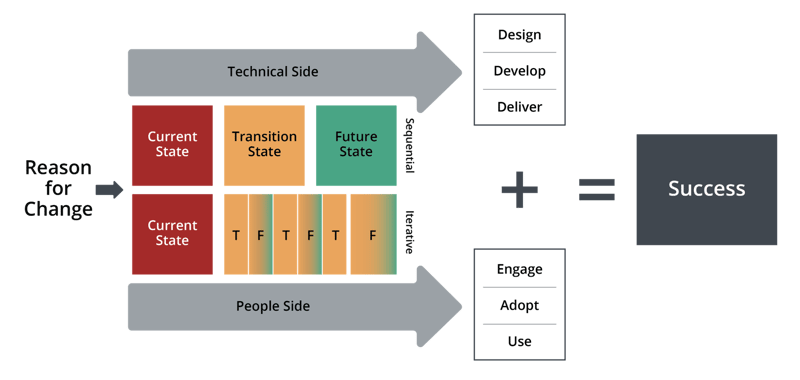Unified Value Proposition of Change Management and Project Management Integration

2 Mins
Updated: August 27, 2025
Published: August 23, 2018

The disciplines of change management and project management cross paths throughout the execution of a project or initiative. Each brings necessary and critical structure for effectively implementing change and realizing results.
Change management and project management, in a combined effort, present a unified value proposition for achieving successful change by providing a foundation for the tactical integration at the people, process and tool dimensions.
Foundation of Integration
Change, at its most basic level, is about moving from a current state through a transition state to arrive at a future state. The goal of change is to improve performance in some meaningful way so that performance levels of the future state are better than what was the current state. Organizations both in the public and private sectors introduce projects or initiatives as ways to add structure to change.
The movement from the current to the future state occurs on two dimensions:
- From a technical perspective: a solution that will address the issue or opportunity must be designed, developed and delivered into the organization
- From a people side perspective: a solution that will truly deliver results must be embraced, adopted and used by those groups impacted by the solution

Complementary Disciplines With a Common Objective
Project management and change management are complementary disciplines because they each provide focus, processes and tools for moving through the transition toward the future state. The common objective, in times of change, is to improve the performance of the organization with a project or initiative—to reach a desired future state. A successful change is characterized by a solution that is effectively designed, developed and delivered (project management) and that is embraced, adopted and used by impacted employees (change management).
Without an approach for both the technical side and people side of change, organizations are unable to deliver sustainable results through change. The Unified Value Proposition of applying both project management and change management is actually quite simple: delivering intended improvement through successfully implemented change programs.
Proposition Value
In addition to the value of integrating the disciplines, there is further value to change management practitioners in sharing this Unified Value Proposition. How does presenting a joint value proposition help your efforts at change management?
Presenting a joint value proposition:
1. Strengthens Your Case for Change Management
With the joint value proposition, you are better able to get a seat at the table and be involved in early discussions, focusing your conversation on what your audience really cares about: meeting objectives, staying on budget and finishing on time.
2. Contributes Positively to the Perception of Change Management by Project Teams
Prosci's benchmarking research indicates that many change management practitioners are working with project teams that perceive change management as extraneous, which is a major obstacle to project team engagement. With a concrete Unified Value Proposition, you have a foundation for shifting the conversation and overcoming this negative perception.
3. Appeals to the Desire of Project Teams for Structure and Process
By demonstrating that change management is not just soft and fluffy but in fact is the application of a structured process and set of tools aimed at delivering project results, you can begin speaking the same language as the project teams you are engaging.
4. Identifies a Problem While Proposing a Solution
The problem, in this case, is that projects are consistently failing to realize their full benefits, despite having a well-developed and planned technical solution. A perfectly designed technical solution with low adoption and engagement by end users does not deliver value. The solution presented by the joint value proposition is a holistic approach to benefit realization resulting from an integration of project management and change management. Research and experience shows that meeting objectives on time and on budget results from a solution that is designed, developed and delivered effectively and embraced, adopted and used by impacted employees. By integrating change management and project management in a seamless application, you solve the problem of projects failing to deliver results even when meeting technical requirements.
Project management and change management each contribute a critical ingredient to successful change. Although they vary in terms of focus and approach, each are essential in order to navigate the transition state to reach a future state. Successful change ultimately depends on a solution that is effectively designed, developed and delivered and in turn is also embraced, adopted and used proficiently by employees impacted by the change.




